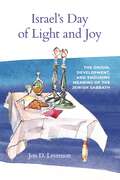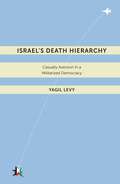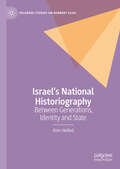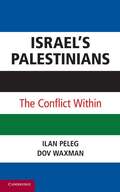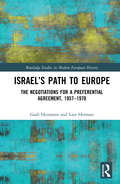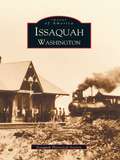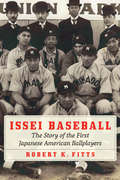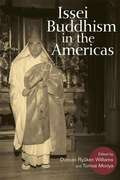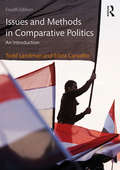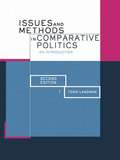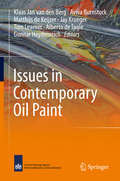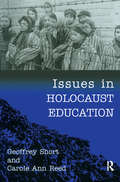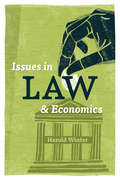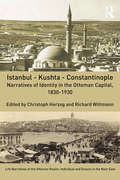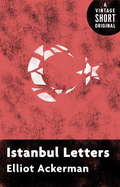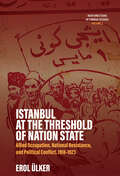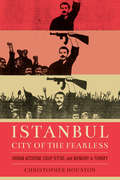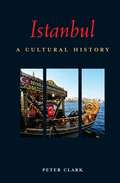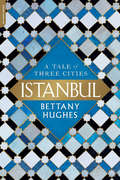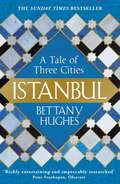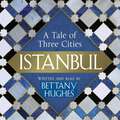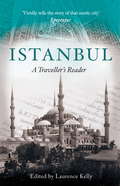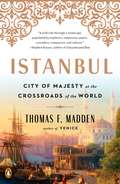- Table View
- List View
Israel’s Day of Light and Joy: The Origin, Development, and Enduring Meaning of the Jewish Sabbath
by Jon D. LevensonThis book begins by exploring the mysterious origins of an institution so familiar that most of us never wonder where it came from—the seven-day week. Jon D. Levenson then focuses on the historical development of the Jewish Sabbath and the rich range of theological and ethical meanings it has acquired over the centuries.Levenson evaluates the theory that the Hebrew word šabbāt derives from Akkadian and that the Sabbath may have begun as a day of ill omen, only later to be reinterpreted as the joyous festival that consummates the seven-day week. He explores the quasi-magical character of the number seven in ancient Near Eastern and Mediterranean compositions and examines the revealing variation of the Sabbath commandment between the two biblical versions of the Decalogue in Exodus and Deuteronomy. He also treats sabbatical law in the Second Temple and rabbinic periods, critiquing contemporary efforts to extract a spirituality from the Sabbath that is divorced from larger questions of communal identity, normative practice, and religious affirmation. Levenson concludes by discussing modern challenges to Sabbath observance and the surprising prospects for its continuation.Written by an eminent scholar in the field, this sophisticated inquiry bridges the gap between studies that explore the spiritual meaning of Jewish Sabbath observance and those that focus strictly on the history of the tradition. It will appeal to a wide audience of academics and lay readers.
Israel’s Death Hierarchy: Casualty Aversion in a Militarized Democracy (Warfare and Culture #4)
by Yagil Levy2012 Winner of the Shapiro Award for the Best Book in Israel Studies, presented by the Association for Israel StudiesWhose life is worth more?That is the question that states inevitably face during wartime. Which troops are thrown to the first lines of battle and which ones remain relatively intact? How can various categories of civilian populations be protected? And when front and rear are porous, whose life should receive priority, those of soldiers or those of civilians? In Israel’s Death Hierarchy, Yagil Levy uses Israel as a compelling case study to explore the global dynamics and security implications of casualty sensitivity. Israel, Levy argues, originally chose to risk soldiers mobilized from privileged classes, more than civilians and other soldiers. However, with the mounting of casualty sensitivity, the state gradually restructured what Levy calls its “death hierarchy” to favor privileged soldiers over soldiers drawn from lower classes and civilians, and later to place enemy civilians at the bottom of the hierarchy by the use of heavy firepower. The state thus shifted risk from soldiers to civilians. As the Gaza offensive of 2009 demonstrates, this new death hierarchy has opened Israel to global criticism.
Israel’s National Historiography: Between Generations, Identity and State (Palgrave Studies on Norbert Elias)
by Alon HelledThe book analyses the development of Israel's national identity through the world of local Jewish Zionist historiography. Inspired by Norbert Elias’ historical and figurational sociology, the book examines the different phases and generations in Israel in light of the collective habitus and the nation-state survival unit, set by Zionism. It does so by putting in relation the intellectual profession of history-writing and the processes of state and identity building. It processually pursues the autonomization of the historiographical field in Israel from its socio-genesis in pre-state Israel to recent decades. By combining together well-established literature on the relations between nationalism and statehood and on the particularity of the Israeli case, the book updates the state of the art and opens new debates on Jewish\Israeli exceptionalism, while shedding light on continuity and change in Israeli statehood vis-à-vis the supposed uniqueness of Jewish history, as reinterpreted and codified by Zionism. As it examines the interconnections between local intelligentsia and politics, the enquiry avails of the sociological concepts of “generation,” “habitus,” “survival unit,” “field,” according to the long-period tradition of research in Pierre Bourdieu, Norbert Elias, Max Weber, and more. This rich sociological conceptualization permits to mirror and contextualize Israel’s national identity with both intellectual and sociopolitical emphases. By situating Israeli historians and their profession on the dynamic crossroads and intersections of academia, politics, and greater society, the study delineates the deep meaning of “Israeliness.”
Israel’s Palestinians
by Dov Waxman Ilan PelegArguing that a comprehensive and lasting solution to the Israeli-Palestinian conflict depends on a resolution of the Jewish-Palestinian conflict within Israel as much as it does on resolving the conflict between Israel and Palestinians in the Occupied Territories, this timely book explores the causes and consequences of the growing conflict between Israel's Jewish majority and its Palestinian-Arab minority. It warns that if Jewish-Arab relations in Israel continue to deteriorate, this will pose a serious threat to the stability of Israel, to the quality of Israeli democracy and to the potential for peace in the Middle East. The book examines the views and attitudes of both the Palestinian minority and the Jewish majority, as well as the Israeli state's historic approach to its Arab citizens. Drawing upon the experience of other states with national minorities, the authors put forward specific proposals for safeguarding and enhancing the rights of the Palestinian minority while maintaining the country's Jewish identity.
Israel’s Path to Europe: The Negotiations for a Preferential Agreement, 1957–1970 (Routledge Studies in Modern European History)
by Gadi Heimann Lior HermanRelations between the new state of Israel and the European Union in the first twenty years of the Community’s existence were a major policy issue given the background of the Holocaust and the way the new nation was established. This book focuses on Israel-European Community relations from 1957 to 1975 - from the signing of the Treaty of Rome (1957), which officially established the Common Market, to the conclusion of Israel’s Free Trade Agreement with the Community. It reveals a new and key facet of Israeli diplomacy during the country's infancy, joining the many studies concerning Israel's relations with the United States, France, Germany and Britain.
Issaquah, Washington
by Issaquah Historical SocietyIncorporated as Gilman in 1892, Issaquah was among the earliest communities settled on the east side of Lake Washington. By 1900, immigrants and newcomers were flooding into the town now known as Issaquah to work the mines, mill lumber, and establish farms and businesses. Though the town's growth dwindled with the coal market in the 1920s, families first attracted by the area's business opportunities stayed because they loved the close-knit community. In 1940 the first bridge across Lake Washington heralded a new era of growth, bringing Issaquah within an hour's drive of Seattle. By the time Interstate 90 came through town in the early 1970s, many trademarks of the small town were fading.This collection of photographs, many never before published, illustrates Issaquah's heyday of mining and logging, its quiet years as a rural community, and its recent transformation into a thriving city. Included are scenes of local events such as the annual Issaquah rodeo, the Squak Valley Hot Shots musical group, and the Issaquah Skyport air show. The deconstruction of architectural symbols such as the Issaquah high trestle and an old pioneer home are also documented.
Issei Baseball: The Story of the First Japanese American Ballplayers
by Robert K. FittsBaseball has been called America&’s true melting pot, a game that unites us as a people. Issei Baseball is the story of the pioneers of Japanese American baseball, Harry Saisho, Ken Kitsuse, Tom Uyeda, Tozan Masko, Kiichi Suzuki, and others—young men who came to the United States to start a new life but found bigotry and discrimination. In 1905 they formed a baseball club in Los Angeles and began playing local amateur teams. Inspired by the Waseda University baseball team&’s 1905 visit to the West Coast, they became the first Japanese professional baseball club on either side of the Pacific and barnstormed across the American Midwest in 1906 and 1911. Tens of thousands came to see &“how the minions of the Mikado played the national pastime.&” As they played, the Japanese earned the respect of their opponents and fans, breaking down racial stereotypes. Baseball became a bridge between the two cultures, bringing Japanese and Americans together through the shared love of the game.Issei Baseball focuses on the small group of men who formed the first professional and semiprofessional Japanese baseball clubs. These players&’ story tells the history of early Japanese American baseball, including the placement of Saisho, Kitsuse, and their families in relocation camps during World War II and the Japanese immigrant experience.
Issei Buddhism in the Americas
by Tomoe Moriya Duncan Ryuken WilliamsRich in primary sources and featuring contributions from scholars on both sides of the Pacific, Issei Buddhism in the Americas upends boundaries and categories that have tied Buddhism to Asia and illuminates the social and spiritual role that the religion has played in the Americas. While Buddhists in Japan had long described the migration of the religion as traveling from India, across Asia, and ending in Japan, this collection details the movement of Buddhism across the Pacific to the Americas. Leading the way were pioneering, first-generation Issei priests and their followers who established temples, shared Buddhist teachings, and converted non-Buddhists in the late nineteenth and twentieth centuries. The book explores these pioneering efforts in the context of Japanese diasporic communities and immigration history and the early history of Buddhism in the Americas. The result is a dramatic exploration of the history of Asian immigrant religion that encompasses such topics as Japanese language instruction in Hawaiian schools, the Japanese Canadian community in British Columbia, the roles of Buddhist song culture, Tenriyko ministers in America, and Zen Buddhism in Brazil. Contributors are Michihiro Ama, Noriko Asato, Masako Iino, Tomoe Moriya, Lori Pierce, Cristina Rocha, Keiko Wells, Duncan Ryûken Williams, and Akihiro Yamakura.
Issei and Nisei: The Settling of Japanese America
by Ronald T. TakakiThe history of Japanese people in America.
Issues and Developments in International Trade Policy
by International Monetary FundThe growth in world trade slowed in the first half of the 1980s compared with both the previous decade and relative to output. the slowdown in the early 1980s was particularly pronounced in developing countries, whose share of world trade has tended to decline. World trade growth picked up during 1986-87 and exceeded the growth of world output, but by a narrower margin than in the 1970s
Issues and Methods in Comparative Politics: An Introduction
by Todd Landman Edzia CarvalhoBuilding on the strengths of the third edition, this highly regarded textbook continues to provide the best introduction to the strategies of comparative research in political science. Divided into three parts, the book begins by examining different methods, applying these methods to dominant issues in comparative politics using a wealth of topical examples from around the world, and then discusses the new challenges in the area. This thoroughly revised and updated edition features: Additional contemporary case studies including the democratisation of technology and the Arab Spring; Detailed discussion of regression analysis and diffusion; More analysis of justice, inequality, and compliance; Reflection on new methods and treatments of contemporary comparative politics. Balancing reader friendly features with high quality analysis makes this popular academic text is essential reading for everyone interested in comparative politics and research methods.
Issues and Methods in Comparative Politics: An Introduction
by Todd LandmanBuilding on the strengths of the first edition, this accessible and user-friendly textbook explores the strategies of comparative research in political science. It begins by examining different methods, then highlights some of the big issues in comparative politics using a wealth of topical examples before discussing the new challenges in the area. Thoroughly revised throughout with the addition of extensive new material, this edition is also supplemented by the availability online of the author's datasets.The book is designed to make a complex subject easier and more accessible for students, and contains: * briefing boxes explaining key concepts and ideas* suggestions for further reading at the end of each chapter* a glossary of terms.
Issues in Contemporary Oil Paint
by Klaas Jan Berg Aviva Burnstock Matthijs Keijzer Jay Krueger Tom Learner Alberto Tagle Gunnar HeydenreichThis volume represents 27 peer-reviewed papers presented at the ICOP 2013 symposium which will help conservators and curators recognise problems and interpret visual changes on paintings, which in turn give a more solid basis for decisions on the treatment of these paintings. The subject matter ranges from developments of paint technology, working methods of individual artists, through characterisation of paints and paint surfaces, paint degradation vs. long time stability, to observations of issues in collections, cleaning and other treatment issues as well as new conservation approaches.
Issues in Holocaust Education
by Geoffrey Short Carole Ann ReedThis original contribution to understanding the nature of Holocaust education in schools tackles an issue that has gained significant interest over the past decade, and is of increasing relevance due to a growing intolerance across Europe and elsewhere. The authors examine a range of issues including the need for Holocaust education, the factors that facilitate or inhibit its evolution, and the indifferent response of the antiracist movement to the attempted annihilation of European Jewry. The empirical content sheds light on the attitudes and practices of teachers and on the prospects of drawing on the Holocaust to further the goal of participatory democracy. The themes and illustrative research are discussed in the context of developments in two locations, the United Kingdom and Canada, and the findings will be germane to an international audience. The volume will prove invaluable to academics and policy makers concerned with social policy, sociology, education and history, as well as to teachers of the Holocaust.
Issues in Law and Economics
by Harold WinterIs file-sharing destroying the music industry? Should the courts encourage breach of contract? Does the threat of malpractice lawsuits cause doctors to provide too much medical care? Do judges discriminate when sentencing? With Issues in Law and Economics, Harold Winter takes readers through these and other recent and controversial questions. In an accessible and engaging manner, Winter shows these legal issues can be reexamined through the use of economic analysis. Using real-world cases to highlight issues, Winter offers step-by-step analysis, guiding readers through the identification of the trade-offs involved in each issue and assessing the economic evidence from scholarly research before exploring how this research may be used to guide policy recommendations. The book is divided into four sections, covering the basic practice areas of property, contracts, torts, and crime, with a fifth section devoted to a concise introduction to the topic of behavioral law and economics. Each chapter concludes with a series of thought-provoking discussion questions that provide readers the opportunity to further explore important ideas and concepts.
Istanbul - Kushta - Constantinople: Narratives of Identity in the Ottoman Capital, 1830-1930 (Life Narratives of the Ottoman Realm: Individual and Empire in the Near East)
by Christoph Herzog Richard WittmannIstanbul – Kushta – Constantinople presents twelve studies that draw on contemporary life narratives that shed light on little explored aspects of nineteenth-century Ottoman Istanbul. As a broad category of personal writing that goes beyond the traditional confines of the autobiography, life narratives range from memoirs, letters, reports, travelogues and descriptions of daily life in the city and its different neighborhoods. By focusing on individual experiences and perspectives, life narratives allow the historian to transcend rigid political narratives and to recover lost voices, especially of those underrepresented groups, including women and members of non-Muslim communities. The studies of this volume focus on a variety of narratives produced by Muslim and Christian women, by non-Muslims and Muslims, as well as by natives and outsiders alike. They dispel European Orientalist stereotypes and cross class divides and ethnic identities. Travel accounts of outsiders provide us with valuable observations of daily life in the city that residents often overlooked.
Istanbul Letters
by Elliot AckermanA Vintage Shorts Original Selection "Why do some forms of violence--the beheading of journalists by the Islamic State, a bombing in Ankara, or the attacks in San Bernardino and Orlando--make us feel so threatened, while other forms--the 372 separate mass shootings in America in 2015 or the 4,219 Syrians killed that same September--do little to challenge our sense of safety?" From his base in Istanbul, Elliot Ackerman has written letters and essays that explore how global and seemingly remote issues like terrorism, US foreign policy, and other geopolitical forces play out and wreak distress upon the quotidian lives of civilians. Here assembled into a haunting piece, the fragments of a year's notes open a window into life under President Recep Tayyip Erdoğan's oppressive and nationalistic right-wing regime, the civil war in Syria, and the disintegration of the old order in the Middle-East. Exposing how a pervasive rhetoric of fear can shape a society and written with intimacy and a tremendous amount of compassion, this is an astute political commentary and first-person travel narrative par excellence. An ebook short.
Istanbul at the Threshold of Nation State: Allied Occupation, National Resistance, and Political Conflict, 1918-1923 (New Directions in Turkish Studies #2)
by Erol UlkerDuring the formation of the Turkish national movement, while Istanbul was under British, French, and Italian occupation, a distinct factional split emerged. One side supported the Ottoman sultanate’s sovereignty, while the other championed a populist, republican path. An Istanbul at the Threshold of Nation State contextualizes this history of coalition, political disintegration, and power struggles in Turkey between 1918 and 1923 to highlight the rise of anti-communist movements and the emergence of national labor and merchant confederations that formed xenophobic, Christian exclusionary policies in the 1920s and 30s.
Istanbul, City of the Fearless: Urban Activism, Coup d'Etat, and Memory in Turkey
by Christopher HoustonBased on extensive field research in Turkey, Istanbul, City of the Fearless explores social movements and the broader practices of civil society in Istanbul in the critical years before and after the 1980 military coup, the defining event in the neoliberal reengineering of the city. Bringing together developments in anthropology, urban studies, cultural geography, and social theory, Christopher Houston offers new insights into the meaning and study of urban violence, military rule, activism and spatial tactics, relations between political factions and ideologies, and political memory and commemoration. This book is both a social history and an anthropological study, investigating how activist practices and the coup not only contributed to the globalization of Istanbul beginning in the 1980s but also exerted their force and influence into the future.
Istanbul: A Cultural History (Interlink Cultural Histories)
by Peter ClarkByzantium, Constantinople, Istanbul: these are only three names that have been given to the city that straddles two continents, was the capital of two multinational empires and is today a vibrant commercial and artistic city, the largest in Turkey and, after Moscow, the largest in Europe. With its location as a port, Istanbul has always absorbed ideas, people and styles from north, south, east and west. Its multiculturalism is a microcosm of the world's. Neither standard guide nor conventional history, this is rather a celebration of an extraordinary city, reviewing its imperial histories and exploring some of its lesser known corners.
Istanbul: A Tale of Three Cities
by Bettany HughesIstanbul has long been a place where stories and histories collide, where perception is as potent as fact.From the Koran to Shakespeare, this city with three names--Byzantium, Constantinople, Istanbul--resonates as an idea and a place, real and imagined. Standing as the gateway between East and West, North and South, it has been the capital city of the Roman, Byzantine, and Ottoman Empires. For much of its history it was the very center of the world, known simply as "The City," but, as Bettany Hughes reveals, Istanbul is not just a city, but a global story.In this epic new biography, Hughes takes us on a dazzling historical journey from the Neolithic to the present, through the many incarnations of one of the world's greatest cities--exploring the ways that Istanbul's influence has spun out to shape the wider world. Hughes investigates what it takes to make a city and tells the story not just of emperors, viziers, caliphs, and sultans, but of the poor and the voiceless, of the women and men whose aspirations and dreams have continuously reinvented Istanbul.Written with energy and animation, award-winning historian Bettany Hughes deftly guides readers through Istanbul's rich layers of history. Based on meticulous research and new archaeological evidence, this captivating portrait of the momentous life of Istanbul is visceral, immediate, and authoritative--narrative history at its finest.
Istanbul: A Tale of Three Cities
by Bettany HughesIstanbul has always been a place where stories and histories collide and crackle, where the idea is as potent as the historical fact. From the Qu'ran to Shakespeare, this city with three names - Byzantium, Constantinople, Istanbul - resonates as an idea and a place, and overspills its boundaries - real and imagined. Standing as the gateway between the East and West, it has served as the capital of the Roman, Byzantine, Latin and Ottoman Empires. For much of its history it was known simply as The City, but, as Bettany Hughes reveals, Istanbul is not just a city, but a story. In this epic new biography, Hughes takes us on a dazzling historical journey through the many incarnations of one of the world's greatest cities. As the longest-lived political entity in Europe, over the last 6,000 years Istanbul has absorbed a mosaic of micro-cities and cultures all gathering around the core. At the latest count archaeologists have measured forty-two human habitation layers. Phoenicians, Genoese, Venetians, Jews, Vikings, Azeris all called a patch of this earth their home. Based on meticulous research and new archaeological evidence, this captivating portrait of the momentous life of Istanbul is visceral, immediate and scholarly narrative history at its finest.
Istanbul: A Tale of Three Cities
by Bettany HughesIstanbul has always been a place where stories and histories collide and crackle, where the idea is as potent as the historical fact. From the Qu'ran to Shakespeare, this city with three names - Byzantium, Constantinople, Istanbul - resonates as an idea and a place, and overspills its boundaries - real and imagined. Standing as the gateway between the East and West, it has served as the capital of the Roman, Byzantine, Latin and Ottoman Empires. For much of its history it was known simply as The City, but, as Bettany Hughes reveals, Istanbul is not just a city, but a story. In this epic new biography, Hughes takes us on a dazzling historical journey through the many incarnations of one of the world's greatest cities. As the longest-lived political entity in Europe, over the last 6,000 years Istanbul has absorbed a mosaic of micro-cities and cultures all gathering around the core. At the latest count archaeologists have measured forty-two human habitation layers. Phoenicians, Genoese, Venetians, Jews, Vikings, Azeris all called a patch of this earth their home. Based on meticulous research and new archaeological evidence, this captivating portrait of the momentous life of Istanbul is visceral, immediate and scholarly narrative history at its finest.Written and read by Bettany Hughes(p) 2017 Orion Publishing Group
Istanbul: A Traveller's Reader
by Laurence KellyIstanbul, A Traveller's Reader is an wide-ranging and carefully chosen selection of writings, offering a richly layered view of Byzantine Constantinople and Turkish Istanbul. During the thousand-year Byzantine empire that followed its founding by Constantine the Great, Istanbul became a city of fabled riches; after falling to the Turks in 1453, its glories continued, maintained by the strength and wealth of the Ottomans.Drawing on diaries, letters, biographies, travelogues and poems from the sixth century AD onwards, this evocative anthology recreates for contemporary visitors the vanished glories of Constantinople. It provides vivid eyewitness accounts of the coronation of a Byzantine emperor; the funeral of a sultan; the triumphal entry of Mehmet the Conqueror; the building of the Süleymaniye, the most magnificent of the city's moques; and the death of Atatürk in 1938.It also describes the rampant sexual exploits of the Byzantine empress-to-be Theodora; the public execution of a Turkish wife and her young, Christian lover; the near execution of an envoy given the unenviable task of transporting a large organ from England to Constantinople in 1599, a gift from Queen Elizabeth to Sultan Mehmet III, who was caught admiring the sultan's personal harem; and the unfortunate Frenchman caught drinking wine and eating a pork sausage while sketching in Hagia Sophia in the 1680s.
Istanbul: City of Majesty at the Crossroads of the World
by Thomas F. MaddenMore information to be announced soon on this forthcoming title from Penguin USA.
